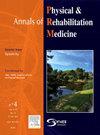Changes in self-reported impairments over 10 years in people with late effects of polio and associated factors: A longitudinal cohort study
IF 4.6
3区 医学
Q1 REHABILITATION
Annals of Physical and Rehabilitation Medicine
Pub Date : 2025-04-18
DOI:10.1016/j.rehab.2025.101969
引用次数: 0
Abstract
Background
Many people ageing with late effects of polio (LEoP) experience new or increased impairments which could negatively influence daily life. Currently, there is limited knowledge how LEoP-related impairments change over time.
Objectives
To assess how various self-reported impairments change over 10 years among people with LEoP, and explore factors associated with the changes.
Methods
This is a longitudinal cohort study, in which 181 people with LEoP (mean age 77 [SD 9] years, 99 women) responded to a postal survey twice, 10 years apart. The survey included questions on demographics, clinical characteristics, and self-reported impairments as assessed with the Self-reported Impairments in Persons with late effects of Polio (SIPP) scale. The SIPP comprises 13 items and asks how much participants have been bothered by various LEoP-related impairments during the past 2 weeks. Changes in SIPP scores were analyzed by paired sample t-test. Factors associated with the changes in SIPP total scores were analyzed with univariable linear regression analyses.
Results
Seven items in the SIPP increased significantly over the 10 years (P < 0.05): muscle weakness, muscle fatigue, sensory disturbances, breathing difficulties at rest and during physical activity, cold intolerance, and general fatigue (corresponding to 1–12%). The SIPP total score increased on average 1.64 points (CI, 0.88 - 2.41, P < 0.001), corresponding to 6%. Two variables were significantly associated with the change in SIPP total score: self-reported degree of LEoP-related disability (B = 2.96, 95% CI, 0.88–5.03; P = 0.006) and presence of co-morbidities (B = 1.72, 95% CI, 0.14–3.30; P = 0.033).
Conclusions
Impairments following LEoP seem to increase over a 10-year period but to a small degree. Having moderate to severe LEoP-related disability and comorbidities are associated with increased impairments. These findings can be accommodated in follow-ups and when providing and developing person-centered interventions for people with LEoP.
脊髓灰质炎晚期影响及相关因素患者10年内自我报告损伤的变化:一项纵向队列研究
背景:许多患有脊髓灰质炎晚期影响的老年人会出现新的或加重的损伤,这可能对日常生活产生负面影响。目前,关于leop相关损伤如何随时间变化的知识有限。目的评价LEoP患者自我报告的各种损伤在10年内的变化,并探讨其变化的相关因素。方法:本研究是一项纵向队列研究,共有181名LEoP患者(平均年龄77岁[SD 9],其中99名女性)接受了两次邮寄调查,间隔10年。该调查包括人口统计学、临床特征和自我报告的损伤(用脊髓灰质炎晚期影响者自我报告损伤量表评估)等问题。SIPP包括13个项目,询问参与者在过去两周内受到各种与leap相关的障碍的困扰程度。采用配对样本t检验分析SIPP评分的变化。采用单变量线性回归分析影响SIPP总分变化的相关因素。结果SIPP的7个项目在10年内显著增加(P <;0.05):肌肉无力、肌肉疲劳、感觉障碍、休息和运动时呼吸困难、不耐寒和全身疲劳(对应1-12%)。SIPP总分平均上升1.64分(CI, 0.88 ~ 2.41, P <;0.001),对应于6%。两个变量与SIPP总分的变化显著相关:自我报告的leap相关残疾程度(B = 2.96, 95% CI, 0.88-5.03;P = 0.006)和合并症的存在(B = 1.72, 95% CI, 0.14-3.30;P = 0.033)。结论LEoP术后损伤在10年内呈增加趋势,但幅度较小。中度至重度leo相关残疾和合并症与损伤增加有关。这些发现可用于后续随访以及为LEoP患者提供和制定以人为本的干预措施。
本文章由计算机程序翻译,如有差异,请以英文原文为准。
求助全文
约1分钟内获得全文
求助全文
来源期刊

Annals of Physical and Rehabilitation Medicine
Medicine-Rehabilitation
CiteScore
7.80
自引率
4.30%
发文量
136
审稿时长
34 days
期刊介绍:
Annals of Physical and Rehabilitation Medicine covers all areas of Rehabilitation and Physical Medicine; such as: methods of evaluation of motor, sensory, cognitive and visceral impairments; acute and chronic musculoskeletal disorders and pain; disabilities in adult and children ; processes of rehabilitation in orthopaedic, rhumatological, neurological, cardiovascular, pulmonary and urological diseases.
 求助内容:
求助内容: 应助结果提醒方式:
应助结果提醒方式:


